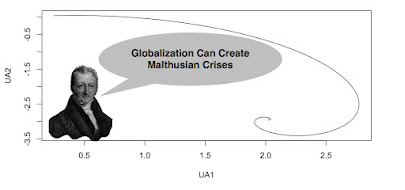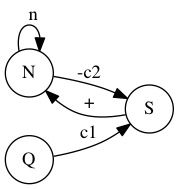Causal Macrosystems
...Nobody has yet developed the mathematical equations and computer models needed to do really good economic predictions--Allan Marks, 2012.
State Space Models
Friday, March 14, 2025
World-System (1950-2010): The Ukrainian Economy
Tuesday, January 14, 2025
Black Box, Isomorphic Cybernetic Systems
Notes
Saturday, December 14, 2024
A Simple Basic Causal Macro Impact Model
NOTES
Code
If you would like to run the R program in your web browser, cut and paste the following code into the editor window at https://rdrr.io/snippets/.
Kaya <- function (time=100,N=100,n=1.4,L=50,Q=100,q=1.04,CO2=1,
Temp=1,l=.5,e=.75,c=.0002,t=.0001,limit=1) UseMethod ("Kaya")
Kaya.default <- function (time=100,N=100,n=1.4,L=50,Q=100,q=1.04,CO2=1,
Temp=1,l=.5,e=.75,c=.02,t=.01,limit=1) {
TEMP <- matrix(0,time,1)
TIME <- matrix(0,time,1)
for (i in 1:time) {
N <- N * n;
L <- N * l; Q <- Q * q + L * e; CO2 <- Q * c; Temp <- CO2 * t; TEMP[i,1] <- Temp; TIME[i,1] <- i; if (i > time/2) {c <- c * limit} } plot(TIME,TEMP) } par(mfrow=c(2,2)) # Sample Function Calls Kaya(n=1.03,q=1.04) title(main="Exponential") Kaya(n=.9,q=1) title(main="Asymptote") # De-Growth Kaya(n=.9,q=.9) title(main="Degrowth") # Decline Kaya(n=.6,q=.6) title(main="Decline") Kaya(n=1.03,q=1.04,limit=0.95) title(main="IPCC Slow") Kaya(n=.9,q=1,limit=0.95) title(main="IPCC Fast")
Monday, November 25, 2024
The Malthusian Controller
There are lots of versions of the Malthusian Model. Understanding the model, which is very simple (see the directed graph, DG, above) is complicated by all the verbal expositions and criticisms of the model (Marx called it a "stain on the human race"). The model basically says that if the means of subsistence (production, Q, in the DG) does not expand as rapidly as population (N, in the graph above) then the Standard of Living (S) will decrease eventually creating a Malthusian Crisis.
From the standpoint of World-Systems Theory and Cybernetics, the Standard of Living (S) is the Malthusian Controller that keeps population growth in check. Although populations in Western Core Countries have had little or no experience with Malthusian Crises, the Malthusian model is still applicable to historical situations and may, in the future, become applicable to Western societies if Climate Change reduces Q.
You can run R-code to experiment with the Malthusian Systems Model (with feedback) here and produce the time series plot above with shock decomposition. The model is taken from Germany after Unification in 1871 when there was a brief Malthusian crisis.
Notice that after 1890, a Malthusian Equilibrium is reached when population and production are in balance.
Wednesday, April 22, 2015
Where are all the Alien Super-Civilizations?
- Possibly, advanced technological civilizations always self-destruct. In the 13.8 billion years since the Big Bang, civilizations such as ours have come and gone, collapsing from energy limits, environmental damage, nuclear war, etc.
- Possibly, any sufficiently advanced, successful technological civilization would be indistinguishable from Nature (a position originally argued by science fiction author Karl Schroeder). Successful advanced civilizations would be more integrated with their natural environments, slower growing (even Steady-State systems), striving for technological efficiency and coming ever-closer to thermodynamic equilibrium.
Sunday, December 28, 2014
The Steady State Economy: Realistic Model or Illusion?
The idea of a steady state economy has a long history. It was discussed by Adam Smith, John Stuart Mill, John Maynard Keynes, Nicholas Georgescu-Roegen, E.F. Schumacher, Kenneth Boulding, and Herman Daly (all discussed here). Basically, the theory of economic growth describes the conditions under which an economy will grow (I've discussed the neoclassical growth model here) and steady-state economy theory describes the conditions under which the economy will stop growing (without collapsing). Both of these theories are flawed for reasons described by the theory of complex dissipative systems. I'll introduce some of these ideas in this post, but my major objective is to introduce the concept of steady state.
The fundamental insight from the steady state economy model is displayed in the graphic above taken from Herman Daly's (1977) Steady State Economics (San Francisco: Freeman) on page 35. Economic growth theory takes up the right-hand box in the figure. The economy, in Daly's view, produces stocks of artifacts (capital goods and stocks of knowledge) that not only deplete the Ecosystem (the left-hand box) but also generate pollution (even knowledge production does this, think of your University's power plant). Compared to the Ecosystem, which is open to Solar Energy and accepts heat pollution, the Economic system is closed. From my earlier discussion of economic growth theory (here), the economy is typically thought to be open to population growth and technological change. Daly includes both those stocks (the stock of population and the stock of knowledge) within the economic system.
If we split the drawing in half, the economy is open to input from the Ecosystem and the Ecosystem is open to pollution and depreciation from the economy as well as solar input. The theory of open systems shows that only closed systems can reach a permanent steady state. An open system is always forced into another state by its inputs. So unless solar energy becomes an input to the Economy and, at the same time, regenerates the Ecosystem which is being depleted but the Economy, the combined system cannot reach a permanent steady state at a high level of economic development. Basically, the Second Law of Thermodynamics holds that all closed systems run down due to dissipation of energy (the theory of complex dissipative systems).
What is lurking under all this theory is the concept of openness. The subtleties are easier to understand by considering the general open system S(t) = A S(t-1) + B X(t-1) where t is time, S is the state of the system, A and B are matrices of coefficients and X is a matrix of inputs from the environment (the open part of the system). The characteristic behavior of the state-space representation is determined by properties of the A matrix, specifically its stability (all eigenvalues of A less than one). If the system is stable it will reach a steady state only when X becomes zero, that is, when the inputs are dissipated (think of X as the environment) or when X becomes a constant, that is, the environment reaches a steady state. If the system is unstable, it will growth forever, even without inputs--which is impossible. So, real world systems must ultimately become stable.
But, imagine a world which is radically open. There are all sorts of systems, some stable, some unstable (think of normal cells in the human body and cancer cells, the cancer cells are growing unstably). Each system is interacting with other systems. In this disorderly world, change over time is determined by the unstable systems. Unless the unstable systems are stabilized, they take over the stable systems. In the case of cancer cells, without killing the cancer cells (one type of steady state) they eventually kill the host system.
The view of the ecological system and the economic system advanced by the theory of steady state economics involves mildly open, stable systems. What if they are not? What if they are more like the human body? What if the Economy and the Ecological system are radically open? This will be a topic for a future post.
The theory of radically open systems possess serious problems for all attempts to specify the steady state or even the growth path of an economy. All the conclusions from economic growth theory, steady-state economic theory and simple open systems theory depend on being able to specify the state S of the system. In radically open systems, if the state is misspecified then some unmeasured, unstable force in the environment (e.g., a cancer pathogen) can disrupt the system and make forecasting the future impossible. In a world of radically open systems, all systems are weakly state determined and strongly driven by the environment. For theorists and model builders, accustomed to specifying system states, specifying the entire environment is an impossible task. For us consumers of theories and models, we need an answer to the question of how open our real word systems are before we an have much faith in the conclusions of theoreticians and model builders.
The one question that the debate between economic growth theorists and steady-state economists has brought into the open is whether any of our economic systems are moving toward a steady state. And, if an economic system is moving toward a steady state (an empirical question) what might happen after that (a speculative question). The resolution of this question is important because it impacts the Ecosystem on which the Economy depends. I will present historical data from and test actual economics systems in future posts (something that is seldom done in ECON 101).
HISTORICAL NOTE
Code
Thursday, June 26, 2014
Is Climate Change an Economic Problem?
- Download the DICE users manual (here). How well was the model validated? What evidence was offered to support using the model for policy experiments? How were the model parameters determined? Evaluate Ackerman's (2007: 1657 here) concern that "...the optimistic projections and modest optimal policies often attributes to models such as DICE may be artifacts of parameter choices, rather than robust forecasts about an uncertain future" For more topics to pursue in the DICE manual, see below.
- Follow up on the references offered in the DICE manual, particularly the Ramsey model (the one that DICE is based on here) and versions of DICE that are not deterministic (here). Try to find a reference that validates the model on historical data.
- Download the "Simple Excel" version of DICE (here and here). Try to understand the model and explore different runs. Make simple changes to the alternative assumptions. NOTE: the Excel model seems "under development" and I have not been able to get it running. Skip to Exercise 4 if you're having trouble.
- Download the free educational version VENSIM PLE (here) and the version of DICE in the VENSIM language from Tom Fiddaman's System Dynamics Model Library, specifically here. Become familiar with the VENSIM language. Most of the causal macrosystems I will review have been implemented in VENSIM and it is free.
- DICE is an optimization model. "...the use of optimization can be interpreted in two ways: First, from a positive point of view, optimization is a means of simulating the behavior of a system of competitive markets; and, second, from a normative point of view, it is a possible approach to comparing the impact of alternative paths or policies on economic welfare" (p. 6)
- "In the DICE and RICE models, the world or individual regions are assumed to have well-defined preferences, represented by a social welfare function, which ranks different paths of consumption" (p. 6).
- "Technological change takes two forms: economy-wide technological change and carbon-saving technological change. The level of total factor productivity ... is a logistic equation similar to that of population...TFP growth declines over time" (p. 9). This is an interesting change of specification. In the neoclassical economic growth model, TFPG is simply an exponential function, meaning it increases forever since there are no inherent limits to the growth of knowledge (see my earlier post here).
- "...providing reliable estimates of the damages from climate change over the long run has proven extremely difficult" (p. 10 and following).
- "The DICE-2013R model explicitly includes a backstop technology, which is a technology that can replace all fossil fuels" (p. 13).
- "The model assumes that incremental extraction costs are zero and that carbon fuels are efficiently allocated over time by the market" (p. 14)
- "As with the economics, the modeling philosophy for the geophysical relationships has been to use parsimonious specifications so that the theoretical model is transparent and so that the optimization model is empirically and computationally tractable" (p. 15).
- "This discussion implies that we can interpret optimization models as a device for estimating the equilibrium of a market economy. As such, it does not necessarily have a normative interpretation. Rather, the maximization is an algorithm for finding the outcome of efficient competitive markets" (p. 22). How well does this interpretation fit the world system?
- "The real interest rate is a critical variable for determining climate policy" (p. 25).
- "Earlier versions of DICE and other IAMs tended to have a stagnationist bias, with the growth rate of total factor productivity declining rapidly in the coming decades. The current version assumes continued rapid total factor productivity growth over the next century, particularly for developing countries" (p. 36).
- "The 2007 model over predicted output by about 6 percent, primarily because of failure to see the Great Recession. We have reduced output to put the new path on the current starting point" (p. 41).
- "Since many computerized climate and integrated assessment models contain between 10,000 and 1 million SLOC...[source lines of code]..., there is the prospect of many bugs contained in our code" (p. 52).
- "...there is a tendency to develop models that increase in parallel with the rapidly expanding frontier of computational abilities. This leads to increasingly large and complex models. We need also to ask, do we fully understand the implication of our assumptions? Is disaggregation really helping or hurting?" (p. 53)
- "The properties of linear stochastic systems are moderately well-understood, but that is not the case of all non-linear stochastic systems" (p. 54).
















